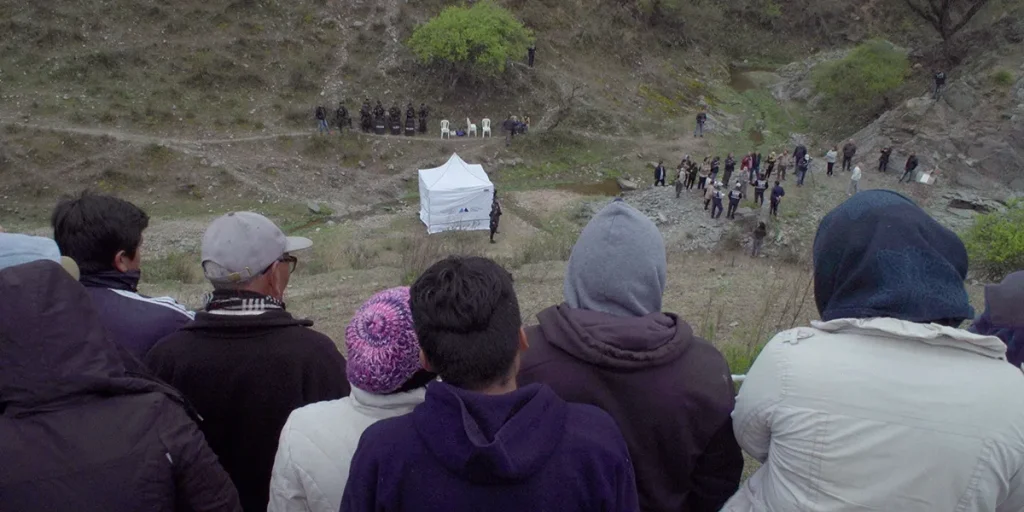In Landmarks (Nuestra Tierra), Lucrecia Martel’s first documentary film, the director’s interrogation of colonialism is as fierce as ever.
Director: Lucrecia Martel
Genre: Documentary
Run Time: 122′
BFI London Film Festival Screening: October 16-17, 2025 (Official Competition)
U.S. Release Date: TBA
U.K. Release Date: TBA
Lucrecia Martel (The Headless Woman) is a rare talent. She crafts films that are at once feverishly ambiguous and enigmatic whilst also being rooted in realism and laced with social commentary. In Landmarks (Nuestra Tierra), which is her fifth feature but her first documentary, her trademark style is perhaps less recognisable with a more linear approach to the subject material, but this doesn’t make the film any less vital than her others.
Like her two best films, La Cienaga (2001) and Zama (2017), Landmarks touches on themes of colonialism and classism in different ways, but still with ripe results.
The opening of Landmarks, in which shots of outer space are viewed to the aural backdrop of rural Argentina, hints at something more experimental from Martel. Shortly after these establishing shots, she guides us to ground level—namely, a courtroom and the aforementioned exteriors of Argentina—and slips into a more conventional routine. There are still interesting qualities on display; in particular, the sound editing in these earlier stages is riveting in its distortion, working to build unease around the impending trial. Being prosecuted are three men charged with the murder of Javier Chocobar, an indigenous leader of the Chuschagasta people.
After these initial courtroom scenes, Landmarks settles into its absorbing, if metronomic, rhythm, as it switches between this judicial setting and the telling of stories from various people of the Chuschagasta community. It can be formulaic at times and too heavy on information, but for the most part, it’s an emotive watch, one guided by the strong directorial hand of Martel. Her visual style shines through; with the aid of Ernesto De Carvalho’s (Adeus, Capitão) cinematography, Martel imbues the Argentinian landscape with potent meaning and tangible history. This is despite the best efforts from people such as those on trial to destroy or alter it. Because whilst Landmarks shines an important spotlight on this specific trial, it also stands as a broad monument to tradition.
Photography plays a massive part in Martel’s documentary. Many of the Chuschagasta people who tell their own stories do so via photos, old and new, capturing times when their community was free to live on their land without threat of persecution. These times were not long lasting, however, shown in the careful and analytical presentation of how indigenous communities throughout this region were exploited or misled. One man, for example, could not read, but was still forced to sign over land deeds to others by his fingerprints. Landmarks is admirably patient in setting out these historical persecutions that feed into the present day, its quiet rage and sorrow even more potent than loud screams of anger.
A single sentence written years ago by a historian is constantly brought up by the defence team. Said historical writer stated that the Chuschagasta people became extinct in the early 1800s, thus giving up all rights to their land. As adept as ever, Martel quickly cuts to the historian, who shows no memory of writing these words, let alone providing any research or evidence behind such an incorrect statement. It is indicative of the way the majority have used their wealth to rewrite history, to drive communities such as the Chuschagasta from where they have existed for centuries. Landmarks emotively delivers this message with precision and clarity, presenting a startling portrait of heritage that exists in the past and present, and that must be preserved for the future.
Landmarks (Nuestra Tierra): Movie Plot & Recap
Synopsis:
Landmarks follows the murder of indigenous leader Javier Chocobar, analysing the event itself as well as the history behind it. Through this analysis, it broadens into an insight into colonialism in Latin America.
Pros:
- Impressive visuals give the Argentinian landscape a sense of tradition and history
- Martel furthers these notions by frequently using photography alongside certain stories
- A patient delivery still creates a cocktail of anger and pain
Cons:
- At times, the structure is formulaic and predictable
- Some of the courtroom scenes are too heavy with information
Landmarks (Nuestra Tierra) will be screened at the BFI London Film Festival on 16-17 October, 2025.

